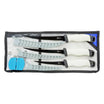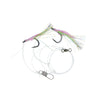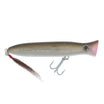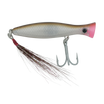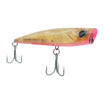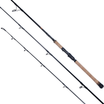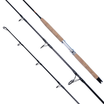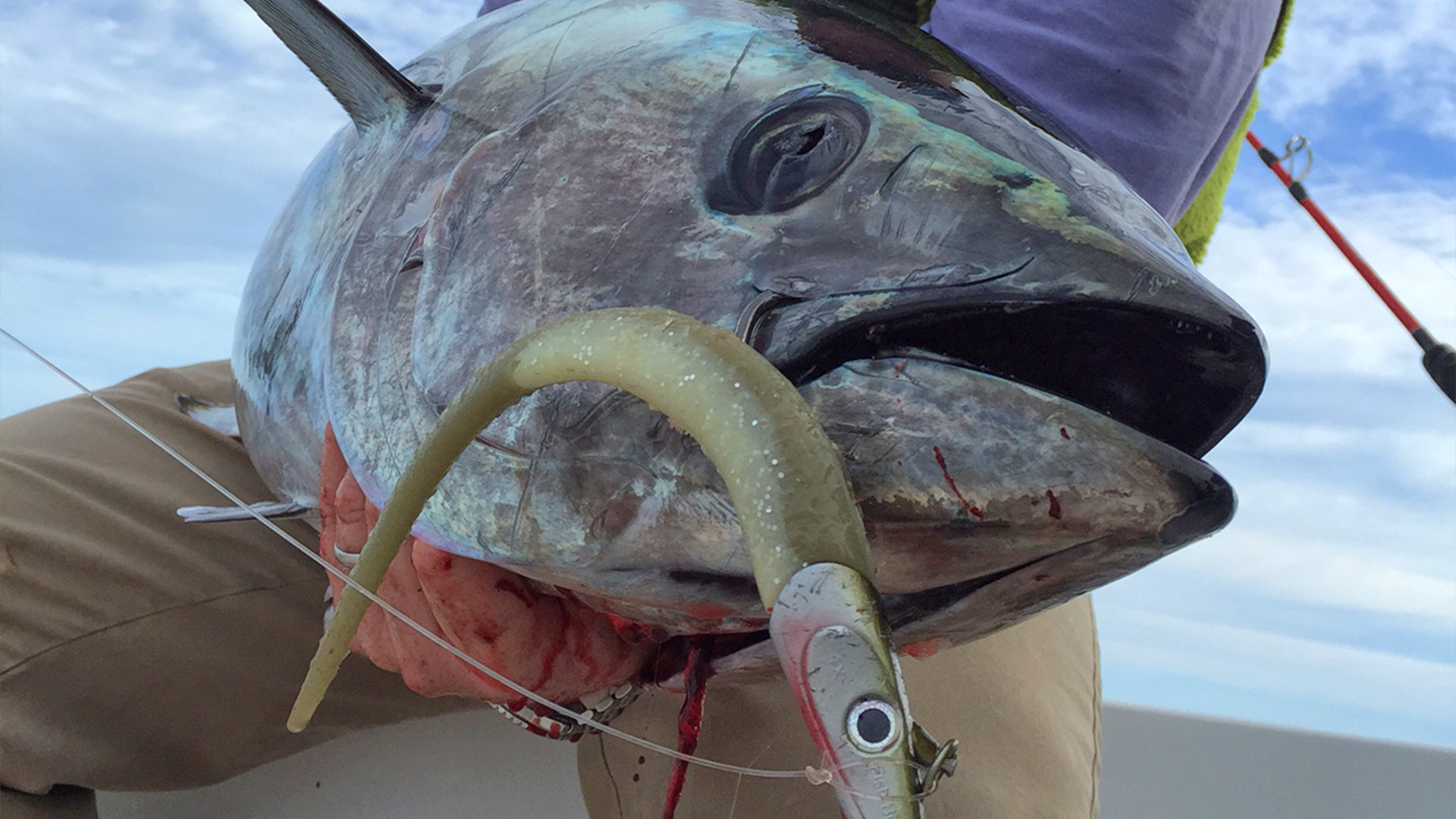Hey folks, Captain Mike here. This is my distillation of my personal approach to tuna fishing where I live by the mantra "Fish Smart. Fish Simple." By this, I mean a system-driven approach that is efficient and responsive to any fishing situation imaginable. With this crate system, you can focus on the fishing and not the gear. The idea is simple: if it doesn’t fit in the crate, it doesn’t come on the trip because you don’t need it!
Crate Contents:
Lure Collection
Our lure selection might be small, but it’s meticulously chosen to cover every situation. Whether facing heavy wind and current, you can fish all levels of the water column from topwater to 400 feet. You can cast or jig, sight cast or blind cast. This collection ensures that you are prepared for virtually any tuna situation you encounter, making it easy to troubleshoot and adapt to changing conditions. With our versatile selection, you are always poised for success on the water.
Topwater Plugs:
- Loud Chug Poppers: Ideal for creating loud noise to attract yellowfin tuna in blue water.
- XL Dogwalkers: Perfect for covering large areas.
- Classic Poppers: Produce subtle noise, making them more suitable for bluefin tuna.
- Usage: Good for blind casting in open areas and calling up fish in side-scan search.
Sliders:
- 6oz Versions: Help sink under aggressive birds. Top colors: olive, pink.
- 4oz Versions: Easier for extended casting. Top colors: chartreuse, amber.
- Usage: Excellent for blind casting key areas and sight casting.
Epoxy Jigs:
- Usage: A jack of all trades, great for various situations. Versatile as casting jigs and upper-level water column vertical jigs. Excellent kerplunk bait. Top colors: sand eel, green/silver.
Soft Baits:
- Eel Tails: Imitate sand eels. Top colors: black, olive.
- Paddle Tails: Imitate larger baitfish like pogies, herring, mackerel, and butterfish. Top colors: white, blue.
- Usage: Eel tails for “kerplunking” bubble feeds and slow jigging, paddle tails for all casting situations.
Vertical Jigs:
- Sand Eel Jigs: Ideal for getting deep and covering ground.
- Weights: 6.5oz to 8.5oz for 140ft or less of water, 12.5oz to 16oz for 150ft or more.
- Include: Backup teasers like Hogy Jig Biki rigs for supplemental groundfishing.
- Usage: Excellent for tactical deep-water jigging.
Color Selection for Lures
Our minimalist approach extends to our color selection, offering a streamlined yet effective palette. We categorize colors into three groups: Attractors, Imitators, and Contrasting Colors.
- Attractors: Bright, high-visibility colors like Albie Crack, pink, and glow are designed to catch the eye of aggressive feeders.
- Imitators: Natural colors such as silver, blue, olive, and green mimic common baitfish like herring, menhaden, and sand eels.
- Contrasting Colors: Stand-out options like black provide a stark contrast, ideal for getting noticed in various conditions.
- Imitate: Effectively mimic herring, menhaden, squid, half beaks, sand eels, and butterfish.
Terminal Tackle
- Swivels, Split Rings, and Crimps: Organized in a dedicated box for quick access.
- Chafe Gear and Hooks: Extra hooks, both inline and treble, for various rigging needs.
- Leaders: Wind-on tuna leaders for both casting and jigging.
Tools and Accessories
- Pliers: Regular pliers, split ring pliers for offshore lure adjustments, and crimpers.
- De-hooker and Scissors: Handy for removing hooks and preparing bait.
- Knives: Short knives for bleeding fish and larger ones for cleaning and filleting.
- Gloves: Provide extra finger strength for casting heavy lures, palming the spool for extra drag, and landing fish.
Approaches This Crate Can Handle
- Walk and Gun to Breaking Fish: This moderate-speed approach is ideal for targeting periodically jumping fish. It combines the advantages of drifting and running and gunning, allowing you to re-position yourself in a fishy area without dramatic RPM changes that could spook fish. Approach slowly when a nearby school pops up. Keep it slow and easy at around 10 knots or less.
- Run and Gun to Breaking Fish: An aggressive, fast-charging approach to get to short-lived feeds. Use lures that can cast far and fast, like epoxy jigs or sliders, to drop in the middle of the feed.
- Tactical Drifts in Heavy Current: Drift over targeted areas while jigging vertically. Deploy vertical jigs to get down quickly and stay in the strike zone.
- Side Scan Search: Use side-scan sonar to locate structures and cast towards them with depth-reaching lures like poppers. Cruise around at 4-8 knots, constantly ready to cast.
- Sight Casting to Cruising Fish: Ideally, approach fish upwind and lead them. Use sliders or paddle tail soft baits for targeting visible fish by leading them.
- Long Drifts Blind Casting: Cast poppers or epoxy jigs while drifting to cover large areas. Continuously cast and retrieve to search for fish.
- Search and Drop: Cruise at slow speeds and drop on fish marked on the fish finder. Use heavy vertical jigs and eel tail soft baits to stop and drop on targets.
Techniques This Crate Can Handle
- Kerplunk Method: Drop heavy epoxy jigs or eel tail soft baits into bubble feeds.
- Dead Sticking: Let heavy harness jigs rock with the boat, imparting a slow natural action through the tail of the softbait, waiting for passing fish.
- Slow Jigging: Use eel tail soft baits or vertical jigs to entice bottom-dwelling fish with a slow, deliberate action.
- Fast Jigging: Employ vertical jigs or paddle tail soft baits for a rapid, attention-grabbing presentation.
- Slow and Low Cranking: Use slow, deliberate retrieves with swimming plugs to maintain lure depth and action.
- Skippy Retrieve with Epoxy Jigs: Utilize a quick, erratic retrieve to mimic fleeing baitfish.
- Pop Pop Pause: Implement a popping action with pauses to entice strikes from predatory fish.
- Start and Stall Crank: Alternate between fast cranking and sudden pauses to trigger reaction strikes.
A well-organized tuna crate is an angler’s best friend. It not only ensures you have all the necessary tools and lures at hand but also helps in maintaining the gear, prolonging its life, and enhancing your overall fishing experience. By following the setup and maintenance tips outlined in this guide, you can maximize your efficiency and success on your next fishing adventure. For more information and a comprehensive gear checklist, check out our 70-page tuna playbook.




















